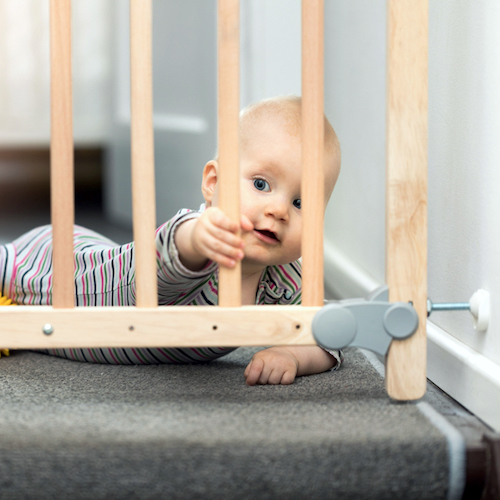Doctors’ Notes
BackBabyproofing Your Home
During the first year of their lives, children explore their surroundings through their senses. They see, touch, hear, smell, and taste everything.
 Because of that, it’s important to ensure that all choking hazards, poisonous products, and items posing an injury risk aren’t accessible — especially when your child starts rolling, crawling, and walking.
Because of that, it’s important to ensure that all choking hazards, poisonous products, and items posing an injury risk aren’t accessible — especially when your child starts rolling, crawling, and walking.
Here are a few common child injury risk categories, with tips to help you prepare a safe home environment for your children.
Choking Hazards
Small household objects that present potential choking hazards — including beads, buttons, coins, screws, pins, magnets, and more — should be stored securely out of reach. Any breakable items, as well as long, flexible cords such as ropes and cables, should also be kept out of reach.
It may be helpful to inspect your home at a child’s eye level — get down on your hands and knees, or even flat to the floor — to identify any unsafe objects he may be tempted to put in his mouth.
Electrical Safety
Children are fascinated by outlets and love to stick small objects in them, which puts them at great risk for injury. Cover all outlets with outlet covers to prevent these potentially tragic accidents.
Chemical Safety
Thoroughly check each room in your home to ensure that all potentially dangerous items are stored out of reach of children — preferably in a locked cabinet with a childproof safety latch.
Dangerous chemical items that should be carefully stored include: bleach; all-purpose cleaners; dishwashing detergent of all types; drain openers and toilet bowl cleaners; laundry detergent of all types (especially the prepackaged pods!); and furniture polish. Remember to consider chemicals that might be found in a garage as well, including antifreeze, windshield wiper fluid, gasoline, and kerosene.
Keep alcoholic beverages a safe distance from your child, and empty unfinished alcoholic beverages immediately.
Though we don’t often think of them as dangerous, many houseplants can be poisonous to children as well.
For additional information, see Dr. Maddalena’s excellent Note on Poison Prevention.
Medications
Medications can look like candy to kids, so the risk of overdose is high. Keep all medications (including both prescription and over-the-counter medicines), as well as vitamins and supplements, stored out of reach in a locked cabinet. Purses and wallets can sometimes have medications in them, so be sure to keep yours out of reach, and make sure to alert visitors to store their bags in a safe place as well.
Remember to read the dosage instructions of any medication you give your child to assure that the medication is safe for children and given at the proper dosage for the child’s size. For more information, see our Note on Fever and Pain Relief Dosing.
Fall Risks
Use a non-slip bathmat in the tub to help prevent bath-time injuries. Install a hardware mounted safety gate to prevent your child from using the stairs before she is developmentally ready. Check furniture and appliances often to ensure they’re secure.
If you’d like to give your child a safe space to play within the home, a playpen is appropriate for brief periods of time.
Fire & Burns
Be sure to have working smoke alarms and carbon monoxide detectors installed throughout the house.
In the kitchen, move the toaster, coffeemaker, and all other electrical appliances out of your child’s reach. Unplug them and hide the cords when they’re not in use.
Use the back burners on the stove whenever possible. If you must use the front ones, turn the pot handles toward the back. Put latches on the doors to the oven, microwave, and refrigerator, and install knob covers on all stove knobs so your child can’t turn on the burners. (If you have a gas stove, you may be able to easily remove the dials when you’re not cooking.)
Consider equipping your kitchen faucet with an anti-scalding device, or setting your water heater to 120 degrees or lower. Install a fire extinguisher in the kitchen, and be sure that every adult in the home knows how to properly use it.
Discuss a fire escape plan with your children once they are old enough to understand.
Drowning
If you have a pool, it’s important to install a fence with a childproof latch and lock around the pool.
Pools are not the only place a child can drown. Remember to never keep buckets of liquid around, to and empty the bathtub as soon as you’re finished using it. Also consider using a toilet seat lid lock, because some kids love playing in the toilet. (Really!)
These tips, combined with close adult supervision should help prevent accidental injuries in your children. If you have any questions or concerns, feel free to call the office anytime!
Mary Upchurch, PA-S, spent a rotation at Kids Plus as a PA Student from Slippery Rock University.